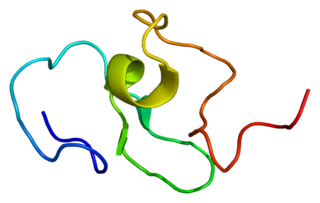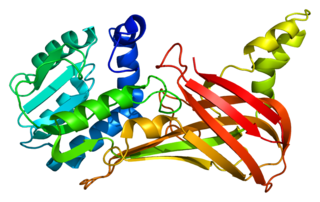
Centromere protein J is a protein that in humans is encoded by the CENPJ gene. It is also known as centrosomal P4.1-associated protein (CPAP). During cell division, this protein plays a structural role in the maintenance of centrosome integrity and normal spindle morphology, and it is involved in microtubule disassembly at the centrosome. This protein can function as a transcriptional coactivator in the Stat5 signaling pathway and also as a coactivator of NF-kappaB-mediated transcription, likely via its interaction with the coactivator p300/CREB-binding protein.

Tyrosine-protein kinase, or Bromodomain adjacent to zinc finger domain, 1B (BAZ1B) is an enzyme that in humans is encoded by the BAZ1B gene.

Sorting nexin-5 is a protein that in humans is encoded by the SNX5 gene.

SET and MYND (myeloid-Nervy-DEAF-1) domain-containing protein 3 is a protein that in humans is encoded by the SMYD3 gene.

Vacuolar-sorting protein SNF8 is a protein that in humans is encoded by the SNF8 gene.

ATPase inhibitor, mitochondrial is an enzyme that in humans is encoded by the ATPIF1 gene.

ATP-dependent RNA helicase SUPV3L1, mitochondrial is an enzyme that in humans is encoded by the SUPV3L1 gene.

Microsomal glutathione S-transferase 3 is an enzyme that in humans is encoded by the MGST3 gene.

Protein arginine N-methyltransferase 3 is an enzyme that in humans is encoded by the PRMT3 gene.

Monofunctional C1-tetrahydrofolate synthase, mitochondrial also known as formyltetrahydrofolate synthetase, is an enzyme that in humans is encoded by the MTHFD1L gene.

Ubiquinone biosynthesis protein COQ9, mitochondrial, also known as coenzyme Q9 homolog (COQ9), is a protein that in humans is encoded by the COQ9 gene.

Putative sodium-coupled neutral amino acid transporter 10, also known as solute carrier family 38 member 10, is a protein that in humans is encoded by the SLC38A10 gene.

Integrator complex subunit 12 (Int12) also known as PHD finger protein 22 (PHF22) is a protein that in humans is encoded by the INTS12 gene.

caprin family member 2, also known as CAPRIN2, is a human gene.

The family with sequence similarity 73, member B, also known as FAM73B, is a human gene.

Mitochondrial translational release factor 1-like is a protein that in humans is encoded by the MTRF1L gene.

Mitochondrial methionyl-tRNA formyltransferase is a protein that in humans is encoded by the MTFMT gene.

Mitochondrial 2-oxodicarboxylate carrier also known as solute carrier family 25 member 21 (SLC25A21) is a protein that in humans is encoded by the SLC25A21 gene.
Protein arginine methyltransferase 7 is a protein that in humans is encoded by the PRMT7 gene. Arginine methylation is an apparently irreversible protein modification catalyzed by arginine methyltransferases, such as PMT7, using S-adenosylmethionine (AdoMet) as the methyl donor. Arginine methylation is implicated in signal transduction, RNA transport, and RNA splicing.

Chromobox homolog 7 is a protein that in humans is encoded by the CBX7 gene. The loss of CBX7 gene expression has been shown to correlate with a malignant form of thyroid cancer.



















